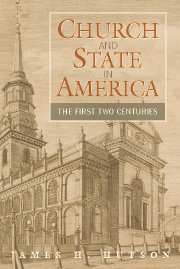2 - To the American Revolution
Published online by Cambridge University Press: 05 June 2012
Summary
The glorious revolution of 1688 occurred when the Dutch Protestant prince, William of Orange, invaded England in November of that year and, without bloodshed, overthrew the Catholic king, James II. The revolution had a momentous effect on both the theory and practice of church–state relations in England and, derivatively, in North America.
The authoritarian policies of James II, which led to his demise in England, were nowhere more conspicuous than in his administration of the North American colonies. When James ascended the throne in 1685, he and his advisers were confronted in North America with a potpourri of colonies whose political and economic conditions were at least as diverse as their religious systems. Weak and insubordinate, they could not defend themselves nor would they enforce English trade regulations. James decided to abolish the proprietary and charter colonies, to consolidate them into two jurisdictions, divided by a line running east to west from a point just north of Philadelphia and to govern them with royal proconsuls.
The success of James's plan, which looked good on paper to imperial bureaucrats, depended on the sensitivity with which it was implemented in the colonies. In 1686 a Dominion of New England was created (eventually containing New York and New Jersey), administration of which was delegated to a military martinet, Sir Edmund Andros. Continuing the English government's religious policy in the colonies, James directed that liberty of conscience prevail in the Dominion.
- Type
- Chapter
- Information
- Church and State in AmericaThe First Two Centuries, pp. 47 - 94Publisher: Cambridge University PressPrint publication year: 2007

